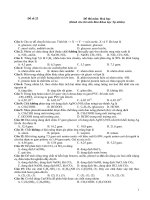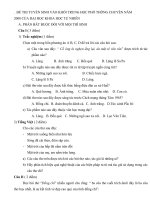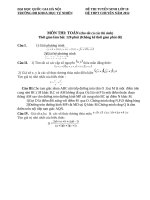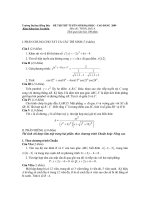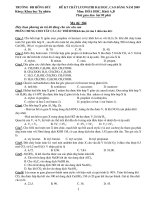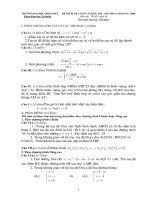Science Process Skills G1 SE_Sách khoa học tự nhiên quyển 1
Bạn đang xem bản rút gọn của tài liệu. Xem và tải ngay bản đầy đủ của tài liệu tại đây (74.37 MB, 416 trang )
Each chapter in your book has a page like this one.
This page shows you how to use a reading skill.
Before reading
First, read the Build Background page. Next, read the How
To Read Science page. Then, think about what you already
know. Last, make a list of what you already know.
Target Reading Skill
The target reading skill will
help you understand what
you read.
Real-World Connection
Each page has an example
of something you will learn.
Graphic Organizer
A graphic organizer can
help you think about what
you learn.
xx
A swamp is a wetland.
Okefenokee Swamp
in Georgia has about
70 islands.
crane 7. Observe Describe a habitat near your
school. What plants and animals live there?
Picture Clues baby birds
dragonfly 8. Use picture
clues to tell
where these
baby birds live.
Test Prep
Fill in the circle next to the correct answer.
1. What does a duck get bullfrog 9. In which habitat might you see a camel?
in a wetland? 35
Ꭽ desert
Ꭾ ocean
Ꭿ rain forest
൳ wetland
2. Use picture clues 10. Tell how a forest
to tell what animals live and a desert are alike and different.
in a wetland.
45
During reading After reading
Think about what you have
Use the checkpoint as learned. Compare what you
you read the lesson. This learned with the list you made
will help you check how before you read the chapter.
much you understand. Answer the questions in the
Chapter Review.
Target Reading Skills
These are some target reading skills that appear in this book.
• Cause and Effect • Draw Conclusions
• Alike and Different • Picture Clues
• Put Things in Order • Important Details
• Predict
xxi
A scientist who wants to
find out about the ocean
observes many things.
You use your senses to
find out about things too.
Scientists classify living
things in the ocean.
You classify when you
sort or group things by
their properties.
Scientists can estimate Scientists use process skills to find
the size of living things out about things. You will use these
in the ocean. This skills when you do the activities in
means they make a this book. Suppose scientists want
careful guess about to learn about living things in the
the size or amount of ocean. Which process skills might
something. Then they they use?
measure it.
Scientists are always
learning about living things
in the ocean. Scientists
draw a conclusion or make
a guess from what they
already know.
xxii
Scientists tell what
they think they will
find before they go
into the ocean.
Scientists might make
and use models.
Models show what
they already know.
Scientists use what
they know to tell what
something means.
xxiii
Think of a question you
have about living things
in the ocean. Make a
statement that you can
test to answer your
question.
Suppose you were a scientist.
You might want to learn
more about the ocean. What
questions might you have? How
would you use process skills to
help you learn?
Scientists record what
they observe and
measure. Scientists
put this data into
charts or graphs.
Scientists use what they
learn to solve problems or
answer questions.
xxiv
Scientists plan and do
an investigation as they
study the ocean.
Scientists plan a fair
test. Scientists change
only one thing in their
test. Scientists keep
everything else the same.
Scientists tell what
they learn about living
things in the ocean.
xxv
Scientific methods are ways of finding answers.
Scientific methods have these steps. Sometimes
scientists do the steps in a different order. Scientists
do not always do all of the steps.
Ask a question. Do seeds need
water to grow?
Ask a question that you
want answered.
Make your hypothesis.
Tell what you think the
answer is to your question.
If seeds are watered,
then they will grow.
Plan a fair test. Water one pot
Change only one thing. with seeds.
Keep everything else the same.
no water water
xxvi
Do your test.
Test your hypothesis. Do your test more
than once. See if your results are the same.
Collect and record your data.
Keep records of what you find out.
Use words or drawings to help.
Tell your conclusion. Seeds need
water to grow.
Observe the results of your test.
Decide if your hypothesis is right
or wrong. Tell what you decide.
water
no water
Go further.
Use what you learn. Think of new
questions or better ways to do a test.
xxvii
Text
Scientists use many different
kinds of tools.
Text Measuring cup
Stopwatch You can use a
A stopwatch measuring cup to
measures how measure volume.
much time Volume is how much
something takes. space something
takes up.
Ruler
You can use a ruler to Computer
measure how long something You can learn about
Textis. Most scientists use a science at a special
ruler to measure length in Internet website. Go to
centimeters or millimeters. www.sfsuccessnet.com.
xxviii
Thermometer
A thermometer measures
the temperature. When the
temperature gets warmer,
the red line moves up.
When it gets cooler, the
red line moves down.
Most thermometers have
a Celsius and Fahrenheit
scale. Most scientists
use the Celsius scale.
xxix
Text
Calculator Safety goggles
A calculator can help You can use safety goggles
you do things, such to protect your eyes.
as add and subtract.
Balance
Text A balance is used to measure
the mass of objects. Mass is how
Meterstick much matter an object has. Most
You can use a meterstick to measure scientists measure mass in grams
how long something is too. Scientists or kilograms.
use a meterstick to measure in meters.
Text
Clock
A clock
measures time.
xxx
Hand lens
A hand lens makes
objects look larger.
Magnet
You can use a magnet to
see if an object is made of
certain metals.
xxxi
ou need to be careful when doing science
activities. This page includes safety tips to remember:
Listen to your teacher’s instructions.
Never taste or smell materials unless your
teacher tells you to.
Wear safety goggles when needed.
Handle scissors and other equipment carefully.
Keep your work place neat and clean.
Clean up spills immediately.
Tell your teacher immediately
about accidents or if
you see something that
looks unsafe.
Wash your hands
well after every
activity.
xxxii
why living things are alive.
that nonliving things were
never alive.
1
living
shelter
2
Chapter 1
Vocabulary
living page 7
shelter page 12
nonliving page 14
nonliving
3
Explore Which is a living thing?
Materials What to Do
bowl with gravel Put the bean seeds
on the gravel.
bean seeds
cup with water
Cover the gravel with water.
Observe for 4 days.
You observe Explain Your Results
when you watch
the seeds and Observe what happens.
the gravel. Tell about the changes you see.
4
Alike and Different
Alike means how things are the same.
Different means how things are not
the same.
Science Pictures
Apply It! Alike Different
Observe the trees.
How are the trees
alike and different?
5
You Are There
Sung to the tune of “Clementine.”
Lyrics by Gerri Brioso & Richard Freitas/The Dovetail Group, Inc.
Plants are living things.
So are animals.
So are people, and I know,
Living things need food and water.
Living things all change and grow.
6
Lesson 1
What are living
things?
Living things are alive.
Living things can grow.
Living things can change.
Plants are living things.
Animals are living things.
People are living things too.
This butterfly is
a living thing.
7 keyword: living
code: g1p7
